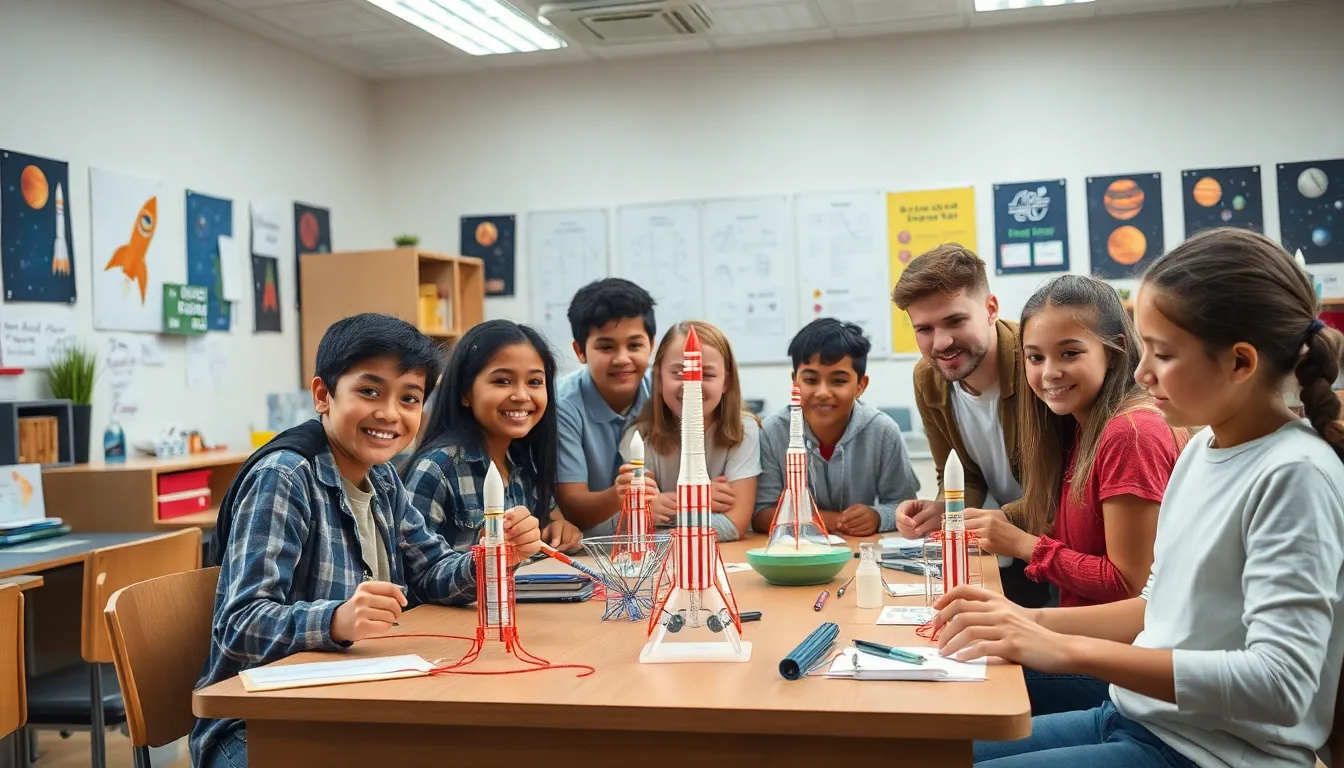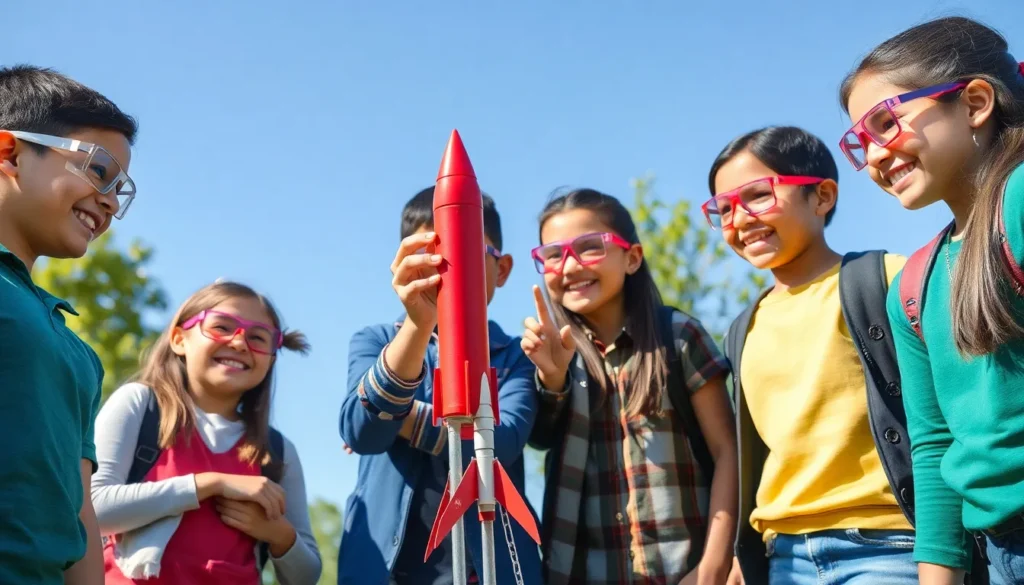Table of Contents
ToggleIn a world increasingly captivated by the mysteries of the cosmos, space education has become essential for inspiring the next generation of explorers and innovators. It’s not just about understanding celestial bodies; it’s about fostering curiosity and critical thinking in young minds. As technology advances, the need for a well-informed populace that can engage with space-related challenges grows ever more urgent.
From hands-on activities to immersive digital experiences, space education encompasses a wide range of approaches that make learning about the universe exciting and accessible. Schools and organizations are stepping up to provide resources that spark interest in STEM fields, ensuring students are equipped for future careers in space exploration and beyond. By investing in space education, society prepares itself to tackle the unknown and unlock the secrets of the universe.
What Is Space Education?
Space education encompasses the knowledge and understanding of the cosmos, involving the study of astronomical phenomena, space exploration, and the principles of physics and engineering that govern space travel. It promotes awareness of planetary systems, galaxies, and beyond, fostering a love for science and technology in students.
Space education integrates various fields, including astronomy, geology, biology, and mathematics, to create a comprehensive learning experience. Programs often include curriculum components focused on rocket science, satellite technology, and environmental impacts of space activities.
Experiential learning plays a crucial role in space education. Engaging methods such as simulations, workshops, and field trips to observatories help students connect theoretical concepts with real-world applications.
Diverse resources support space education, from online platforms providing interactive materials to educational institutions offering specialized courses. Organizations like NASA and the European Space Agency offer free learning resources, contributing to a broader understanding of space science.
As society confronts challenges related to space, such as climate change and resource management, space education fosters critical thinking and problem-solving skills. By preparing students for future opportunities, it ensures a knowledgeable public ready to tackle complex issues in an ever-evolving technological landscape.
Importance Of Space Education

Space education serves as a crucial element in developing skills and knowledge related to the cosmos. It fosters curiosity and problem-solving abilities, preparing individuals to engage with future challenges.
Enhancing STEM Skills
Space education enhances STEM (Science, Technology, Engineering, Mathematics) skills through a hands-on approach. Activities like building model rockets or conducting physics experiments illustrate core principles effectively. Students gain proficiency in scientific inquiry, data analysis, and technical methods, essential for advanced studies and careers in related fields. Engaging curriculum components, such as satellite technology and robotic exploration, stimulate interest and encourage further exploration in STEM disciplines.
Inspiring Future Generations
Space education inspires future generations by igniting passion for exploration and innovation. It encourages young people to envision careers as scientists, engineers, or astronauts, contributing to humanity’s quest for knowledge beyond Earth. Initiatives that promote collaboration with organizations like NASA provide students with unique insights into real-world applications of space science. These connections spark motivation and drive aspirations, cultivating a new generation of thinkers who seek to address pressing challenges through space exploration and research.
Current Trends In Space Education
Current trends in space education focus on innovative and engaging methods to ignite interest among students. This approach integrates technology, hands-on practices, and collaborative efforts to enhance learning experiences.
Online Learning Platforms
Online learning platforms play a significant role in modern space education. They offer flexible access to high-quality courses and resources, allowing learners to study at their own pace. Platforms like NASA’s Digital Learning Network and the European Space Agency’s educational resources provide interactive materials, videos, and virtual lessons. These resources cover topics such as satellite communication, planetary science, and space technology. Utilizing online simulations and gamified learning experiences, students can explore complex concepts in an engaging way. The accessibility of these platforms also promotes global collaboration, enabling students from diverse backgrounds to participate in space education initiatives.
Hands-On Activities
Hands-on activities remain a cornerstone of effective space education. Engaging students through practical experiences fosters a deeper understanding of theoretical concepts. Activities like rocket building competitions, nighttime sky observations, and robotics workshops create opportunities for experiential learning. Projects encourage students to apply principles of physics, engineering, and mathematics, reinforcing their STEM skills. Collaborations with organizations, such as local science museums or observatories, enhance these activities by providing resources and expertise. Participating in events like space-themed summer camps or science fairs allows students to showcase their projects, inspiring creativity and enthusiasm for space exploration.
Challenges In Space Education
Space education faces several challenges that impact its effectiveness and accessibility. Addressing issues like accessibility and resource limitations is crucial for fostering a robust educational environment.
Accessibility Issues
Accessibility issues significantly hinder participation in space education. Geographical limitations often create barriers for students in rural or underserved areas. Many students lack access to quality space education resources, expert instructors, and facilities such as observatories or planetariums. Internet connectivity disparities also limit engagement with online educational platforms that offer valuable content.
Schools in economically disadvantaged regions may struggle to provide up-to-date technology and equipment necessary for dynamic space learning experiences. Additionally, some individuals with disabilities encounter additional challenges when accessing programs and resources, which can discourage their participation in space-related activities.
Resource Limitations
Resource limitations critically impact the quality and reach of space education programs. Financial constraints often affect schools’ ability to develop comprehensive curricula and invest in necessary technology. This lack of funding may prevent the purchase of equipment for hands-on experiments, such as telescopes or robotics kits.
Insufficient collaboration between educational institutions and space agencies can lead to a gap in resources for practical experiences and workshops. Limited availability of trained educators with expertise in space science and related fields can further impede effective teaching. These resource limitations ultimately restrict students’ exposure to practical applications of space science and innovation.
Future Of Space Education
The future of space education hinges on technological advancements and collaborative efforts among nations. These developments aim to enhance learning experiences and expand access to space-related knowledge.
Emerging Technologies
Emerging technologies shape the landscape of space education, making learning more interactive and accessible. Virtual reality (VR) environments allow students to experience space simulations, such as Mars exploration or International Space Station missions. Augmented reality (AR) applications enable students to visualize star constellations and planetary movements through mobile devices, enhancing engagement.
Artificial intelligence (AI) tools analyze student performance, tailoring educational experiences to individual learning needs. Online platforms increasingly incorporate gamification, turning complex concepts into engaging challenges. 3D printing technology facilitates hands-on learning, enabling students to create models of rockets or planetary surfaces, reinforcing theoretical knowledge through practical application.
Global Collaborations
Global collaborations play a crucial role in advancing space education initiatives. Partnerships between nations enable resource sharing and combined research efforts. For example, the International Space Station (ISS) serves as a hub for educational programs, where students worldwide participate in experiments conducted by astronauts.
Organizations like the United Nations Office for Outer Space Affairs (UNOOSA) foster international cooperation, promoting educational outreach in developing countries. Programs such as LEGO Education and ESA’s Space for Education initiative provide resources to schools, ensuring students access to cutting-edge materials and curricula.
Collaborative projects often result in joint educational programs and workshops, where students engage with experts from various fields. These experiences not only broaden perspectives but also encourage diverse approaches to solving space-related challenges.
Space education plays a vital role in shaping the future of exploration and innovation. By fostering curiosity and critical thinking among young learners it prepares them to tackle complex challenges in an increasingly technological world. The integration of hands-on activities and digital experiences enriches the learning journey making abstract concepts tangible and engaging.
As advancements in technology continue to evolve educational methods must adapt to ensure accessibility and inclusivity. Global collaborations can enhance resource sharing and create diverse opportunities for students. Ultimately prioritizing space education not only inspires the next generation of scientists and engineers but also cultivates a society equipped to explore the mysteries of the universe. Through this commitment to education the possibilities for discovery are boundless.



